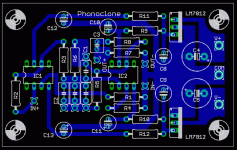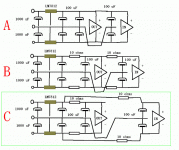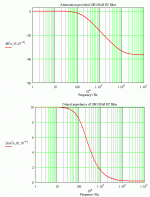Thanks R
That what I could """very"""" distinctly hear when listening and then reversing at cartridge. much appreciated
That what I could """very"""" distinctly hear when listening and then reversing at cartridge. much appreciated
hello RJM
Thanks
the Denon is a 0,35 mv cartridge how much volt
will i have after the phonoclone ?
can i use the OP 37 ?
how can i order the pcbs? i cant open or read te zip files on jour site.
Robert
Thanks
the Denon is a 0,35 mv cartridge how much volt
will i have after the phonoclone ?
can i use the OP 37 ?
how can i order the pcbs? i cant open or read te zip files on jour site.
Robert
The gain of the phonoclone can be set by selecting the value of R2, as explained here.
To cut to the chase, for the DL103 and an output 1-2V (Gain =1.5/.00035= ~4000. First stage gain is 4000/33 = 130) R2= ~5.6k (130*Rs). Use the OP27.
I'm not sure why you can't open the zip file. However, for the benefit of readers living in China, where Geocities is blocked but DIY audio is not, I have attached the file in question.
Please note I will be issuing a new set of PCB files for the phonoclone in the very near future with what I consider to be an "enhanced" power rail.
/R
The mid-band gain of the second stage is roughly 0.6 R5/R3. As shown it is 33, or 30 dB. The gain of the first stage is R2/Rs, where Rs is the cartridge impedance. When using the OP27, the gain of the first stage should ideally be set to about 45 dB for a total gain of 75 dB. For higher gain, set the first stage gain to 60 dB (total gain 90 dB) and substitute a OP37 or similar decompensated op-amp instead of of the OP27.
To cut to the chase, for the DL103 and an output 1-2V (Gain =1.5/.00035= ~4000. First stage gain is 4000/33 = 130) R2= ~5.6k (130*Rs). Use the OP27.
I'm not sure why you can't open the zip file. However, for the benefit of readers living in China, where Geocities is blocked but DIY audio is not, I have attached the file in question.
Please note I will be issuing a new set of PCB files for the phonoclone in the very near future with what I consider to be an "enhanced" power rail.
/R
Attachments
hello RJM
is 0,35 mv .00035...... oops
i tought it was .0035
and i was thinking about 500 Gain
when do you get the new pcbs ?
i will order a pair
but i cant open the zip files
please will you sent me an email ?
Robert
is 0,35 mv .00035...... oops
i tought it was .0035
and i was thinking about 500 Gain
when do you get the new pcbs ?
i will order a pair
but i cant open the zip files

please will you sent me an email ?
Robert
rjm said:frank2395 : The phonoclone maintains the correct polarity.
tubee : Perhaps the gain is set to high?
/R
It is set by the properties of cart, used a Benz gold, allmost the same properties as in the article succesfully used denon mc103 (0.4mV)
The internal impedance of the Benz gold is 20 ohms, so the gain is actually 6dB higher than when a DL103 is used. Not a huge difference I admit, but it moves the circuit gain at low frequencies from an already high 75 dB to over 80 dB.
I should be OK, but the open loop gain of the OP27 at 20 Hz is about 110 dB, something you should in any case bear in mind.
The other thing tha might be worth trying is a small value resistor (20 ohms) between the noninverting input to ground.
/R
I should be OK, but the open loop gain of the OP27 at 20 Hz is about 110 dB, something you should in any case bear in mind.
The other thing tha might be worth trying is a small value resistor (20 ohms) between the noninverting input to ground.
/R
Phonoclone PCB rev. 27a
As promised here is the Eagle .brd file for the latest Phonoclone revision. It is a 1/4 Eurocard, VSPS-sized "mini" board again, the only change from the last published version 26j is to the power distribution lines between the opamps and voltage regulators.
It is configured to the layout I am now using myself - although in my case I jury-rigged version 26j with flying leads to achieve the same thing.
The change is to go with separate, single stage RC filters for each opamp, rather than the RCRC combination originally set in 26j. Its very light filtering, the resistor is only 10 ohms. I suspect most of the difference is from decoupling the opamp from the regulator output rather than noise reduction per se. Anyhow, I find this arrangement works very well.
I havent ordered this from Olimex, so there are no phototools on file with them. You'll have to submit the brd file to them yourself.
/Richard
As promised here is the Eagle .brd file for the latest Phonoclone revision. It is a 1/4 Eurocard, VSPS-sized "mini" board again, the only change from the last published version 26j is to the power distribution lines between the opamps and voltage regulators.
It is configured to the layout I am now using myself - although in my case I jury-rigged version 26j with flying leads to achieve the same thing.
The change is to go with separate, single stage RC filters for each opamp, rather than the RCRC combination originally set in 26j. Its very light filtering, the resistor is only 10 ohms. I suspect most of the difference is from decoupling the opamp from the regulator output rather than noise reduction per se. Anyhow, I find this arrangement works very well.
I havent ordered this from Olimex, so there are no phototools on file with them. You'll have to submit the brd file to them yourself.
/Richard
Attachments
For the non-Eagle-using readers, this is what it looks like.
All the core components are as previous, but the regulator parts are as follows,
C4,C5 : 680 uF
C8,9,10,11,12,13 : 100 uF
R9,10,11,12 : 10 ohms
The above values are "factor of two" accuracy, i.e. the resistors should be between 5-20 ohms, though obviously the same value should be used for each one.
The regs are as stated, LM7812 and LM7912, but 9V or 10 V versions are preferred if you can find them.
All the core components are as previous, but the regulator parts are as follows,
C4,C5 : 680 uF
C8,9,10,11,12,13 : 100 uF
R9,10,11,12 : 10 ohms
The above values are "factor of two" accuracy, i.e. the resistors should be between 5-20 ohms, though obviously the same value should be used for each one.
The regs are as stated, LM7812 and LM7912, but 9V or 10 V versions are preferred if you can find them.
Attachments
Hi Richard,
With my success on the VSPS, I would like to take a stab on the Phonoclone.
Are these the right chips? (Got them from Farnell website)
OP27GPZ — ANALOG DEVICES — IC, OP-AMP LOW NOISE PRECISION
Manufacturer: ANALOG DEVICES
Order Code: 9604626
Manufacturer Part No: OP27GPZ
OP37GPZ — ANALOG DEVICES — IC, OP-AMP PRECISION
Manufacturer: ANALOG DEVICES
Order Code: 9604642
Manufacturer Part No: OP37GPZ
With my success on the VSPS, I would like to take a stab on the Phonoclone.
Are these the right chips? (Got them from Farnell website)
OP27GPZ — ANALOG DEVICES — IC, OP-AMP LOW NOISE PRECISION
Manufacturer: ANALOG DEVICES
Order Code: 9604626
Manufacturer Part No: OP27GPZ
OP37GPZ — ANALOG DEVICES — IC, OP-AMP PRECISION
Manufacturer: ANALOG DEVICES
Order Code: 9604642
Manufacturer Part No: OP37GPZ
Updates to the PCB page
ok, I've finally got around to the big update to thePCB Page. The Eagle files for several different versions of the VSPS and Phonoclone can be downloaded.
Temporarily I have removed the links to the contruction guide pages. I'm going to take another stab at organizing this later when I get a chance.
In the meantime any questions are best delt with here in the forum.
There are now 5 "current" PCBs
VSPS Stereo
VSPS Basic
Phonoclone RC
Phonoclone Standard LM317
Phonoclone BE
all but the BE are 5x8cm, standardized mounting.
I'm currently using the Phonoclone RC myself....
ok, I've finally got around to the big update to thePCB Page. The Eagle files for several different versions of the VSPS and Phonoclone can be downloaded.
Temporarily I have removed the links to the contruction guide pages. I'm going to take another stab at organizing this later when I get a chance.
In the meantime any questions are best delt with here in the forum.
There are now 5 "current" PCBs
VSPS Stereo
VSPS Basic
Phonoclone RC
Phonoclone Standard LM317
Phonoclone BE
all but the BE are 5x8cm, standardized mounting.
I'm currently using the Phonoclone RC myself....
Fran relieved me of my Phonoclone BE, but I still have one pair of Phonoclone LM317 boards (aka Phonoclone mini). They are $20 including shipping worldwide.
I've mostly completed the revisions to the web pages that I have undertaken in order to try and streamline these projects. The information has been split over the following four pages:
VSPS main page
Phonoclone main page
PCB page (now with the information regarding the additional voltage regulation components)
Construction Guide (condensed, no longer separate VSPS and Phonoclone versions)
A lot of information got deleted in the hope that overall the result would be more understandable. In a lot of places a longwinded discussion of different options got replaced by a blunt recommendation: (use this part, do this..).
I would appreciate hearing your opinion re. these changes.
Richard
I've mostly completed the revisions to the web pages that I have undertaken in order to try and streamline these projects. The information has been split over the following four pages:
VSPS main page
Phonoclone main page
PCB page (now with the information regarding the additional voltage regulation components)
Construction Guide (condensed, no longer separate VSPS and Phonoclone versions)
A lot of information got deleted in the hope that overall the result would be more understandable. In a lot of places a longwinded discussion of different options got replaced by a blunt recommendation: (use this part, do this..).
I would appreciate hearing your opinion re. these changes.
Richard
Hi rjm,
I would take that two mini boards if you mind.
email to follow.
btw: the construction page is good now. As it was before.... 😉
Rüdiger
I would take that two mini boards if you mind.
email to follow.
btw: the construction page is good now. As it was before.... 😉
Rüdiger
Comments on voltage regulation
I should explain a little about the phonoclone RC.
In the beginnings of the Phonoclone there was a version, not shown in the image below, where each op-amp was powered by a separate regulator unit. For grouding issues this didnt work properly. So I moved to one regulation unit per channel. Early versions were LM7812 based, then we quickly moved on to the LM317.
Compared to the The LM317 versions the LM7812 sounds a bit rough, and the LM317 offers a blacker background, better definition and dynamics, and wider soundstage. The LM7812 though could be said to sound more natural, more relaxed.
The noise spectrum of the Phonoclone output displayed some high frequency trash as well as higher order line noise.
Unfortunately, getting rid of this involves tradeoffs: either you crank up the feedback on the regulator (reducing stability), or you increase the input filter capacitance (diode and power supply stress), or, via a passive RC filter, you increase the low frequency output impedance of the power supply as seen by the op-amp (poor bass response). I chose to lesser of the three evils, and investigated the RC filter.
The first attempt is shown in (B) below, with a standard multistage filter as used in many tube amps. My initial reaction was positive - smooth, natural sound - but there was something of a "backwash" which I didnt care for. I believe this was due to the relatively strong coupling bewteen the input and output stages through the shared 10 ohm resistor.
So I moved on to (C), which powers both op-amps independantly, directly from the regulator output. The coupling issue is removed. For me this setup is "just the ticket".
In the RC version the op-amp relies very heavily on the adjacent byapss cap since it is isolated from the regulator by the 10 ohm resistor, so it would seem prudent to pay attention to this part. I used Rubycon ZA. In addition to the advantage of noise rejection (actual filtering) the RC stage also decouples the op-amp from the regulator. Insofar as the regulator is sensitive to the load, this gives the regulator less to do and less to worry about so to speak. My gut feeling is that this has more to do with the improved sound than the noise ... indeed the outpuyt noise measurements do not show much difference.
I should explain a little about the phonoclone RC.
In the beginnings of the Phonoclone there was a version, not shown in the image below, where each op-amp was powered by a separate regulator unit. For grouding issues this didnt work properly. So I moved to one regulation unit per channel. Early versions were LM7812 based, then we quickly moved on to the LM317.
Compared to the The LM317 versions the LM7812 sounds a bit rough, and the LM317 offers a blacker background, better definition and dynamics, and wider soundstage. The LM7812 though could be said to sound more natural, more relaxed.
The noise spectrum of the Phonoclone output displayed some high frequency trash as well as higher order line noise.
Unfortunately, getting rid of this involves tradeoffs: either you crank up the feedback on the regulator (reducing stability), or you increase the input filter capacitance (diode and power supply stress), or, via a passive RC filter, you increase the low frequency output impedance of the power supply as seen by the op-amp (poor bass response). I chose to lesser of the three evils, and investigated the RC filter.
The first attempt is shown in (B) below, with a standard multistage filter as used in many tube amps. My initial reaction was positive - smooth, natural sound - but there was something of a "backwash" which I didnt care for. I believe this was due to the relatively strong coupling bewteen the input and output stages through the shared 10 ohm resistor.
So I moved on to (C), which powers both op-amps independantly, directly from the regulator output. The coupling issue is removed. For me this setup is "just the ticket".
In the RC version the op-amp relies very heavily on the adjacent byapss cap since it is isolated from the regulator by the 10 ohm resistor, so it would seem prudent to pay attention to this part. I used Rubycon ZA. In addition to the advantage of noise rejection (actual filtering) the RC stage also decouples the op-amp from the regulator. Insofar as the regulator is sensitive to the load, this gives the regulator less to do and less to worry about so to speak. My gut feeling is that this has more to do with the improved sound than the noise ... indeed the outpuyt noise measurements do not show much difference.
Attachments
Summertime Phonoclone Kit
Its Obon (summer vacation to the rest of the world). I'm thinking, listening to my Phonoclone RC, that this implementation is really pretty darned good, and more importantly is unlikely to get any better any time in the forseeable future. (Partly because I - and you - have tried just about every subconfiguration possible and partly because my free time is going to be basically nil for the next couple of years I expect.)
So as a last hurrah I'd like to propose something a little special:
Full Phonoclone RC Kits, complete with all the parts right down to the resistors, everything exactly as I would build it for myself. In a very limited offer of 10 kits, 9 of which are available (first one stays with me). Special PCB will be customized to the particular parts used before fabrication at Olimex. Signed, numbered certifiicate of ownership.
Cost, including shipping worldwide, will be $145.
First come, first serve. The kits will ship in about two months time, ready for the fall building season.
Richard
Its Obon (summer vacation to the rest of the world). I'm thinking, listening to my Phonoclone RC, that this implementation is really pretty darned good, and more importantly is unlikely to get any better any time in the forseeable future. (Partly because I - and you - have tried just about every subconfiguration possible and partly because my free time is going to be basically nil for the next couple of years I expect.)
So as a last hurrah I'd like to propose something a little special:
Full Phonoclone RC Kits, complete with all the parts right down to the resistors, everything exactly as I would build it for myself. In a very limited offer of 10 kits, 9 of which are available (first one stays with me). Special PCB will be customized to the particular parts used before fabrication at Olimex. Signed, numbered certifiicate of ownership.
Cost, including shipping worldwide, will be $145.
First come, first serve. The kits will ship in about two months time, ready for the fall building season.
Richard
- Home
- Source & Line
- Analogue Source
- The Phonoclone and VSPS PCB Help Desk


